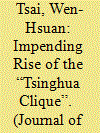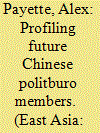| Srl | Item |
| 1 |
ID:
169115


|
|
|
|
|
| Summary/Abstract |
The Tsinghua clique is highly influential in the Chinese Communist Party (CCP) politics. But in the past, alumni from other elite universities, such as Peking University and Renmin University of China, also occupied positions as senior cadres, so Tsinghua did not have any more influence than they did. However, since 2002, Tsinghua University has developed a ‘cultivation/transfer’ system whereby the school, in a purposeful, calculating, and organized manner, selects and trains talented students and then places them in political posts after graduation. After these students enter officialdom, they strengthen their ties with other alumni through their connections with the Tsinghua authorities and the Tsinghua Alumni Association. With this system in place, Tsinghua alumni account for the majority of ‘post-1980 generation’ county-level leading cadres. The authors therefore predict that the ‘Tsinghua clique’ will gain even stronger political influence, and Tsinghua University will likely become the most significant university for cultivating senior cadres.
|
|
|
|
|
|
|
|
|
|
|
|
|
|
|
|
| 2 |
ID:
152342


|
|
|
|
|
| Summary/Abstract |
Efforts at finding the next Politburo members have, since the mid-1970s, been at the center of Chinese Elite and leadership studies. From the late 1980s onwards, leadership selection has become more institutionalized. This allows scholars to narrow down their search to more “propitious” elements in order to try to predict who might ascend to the Politburo. Consequently, this article ponders if it was possible to differentiate these individuals from their less “promotable” counterparts upon their entry into the Central Committee between 1992 and 2012. Based on statistical reassessment of variables commonly found in the literature, the article argues that soon-to-be Politburo members were already displaying a different profile than that of their counterparts 5 to 10 years before their entry into the Politburo. This article does not seek to establish a perfect predictive model rather than circumscribe the profile-type and environment in which these rising Elites can be found. Lastly, the latter opens a discussion on what to expect from the results as well as competing profiles found inside the Central Committee.
|
|
|
|
|
|
|
|
|
|
|
|
|
|
|
|